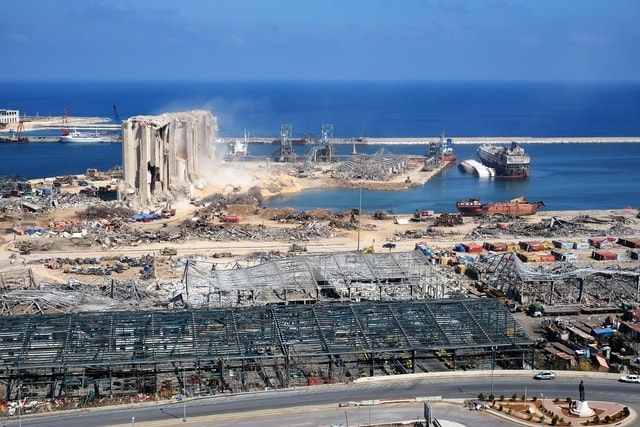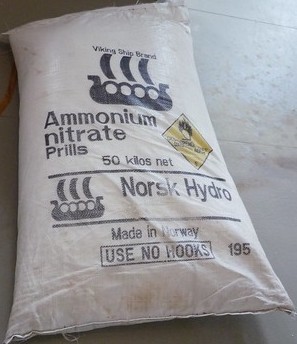6.9: Mass Percent Composition from a Chemical Formula
- Page ID
- 289389
⚙️ Learning Objectives
- Determine the percent composition of each element in a compound from the chemical formula.
Nitrogen is a nutrient essential for plant growth. Two common fertilizers used by farmers to supply nitrogen are ammonia (NH3) and ammonium nitrate (NH4NO3). Ammonia is applied as a gas under pressure, called anhydrous ammonia. Ammonium nitrate is applied as a solid. Both have special handling precautions. Ammonia is highly soluble in water and will quickly dissolve in any water that is exposed. In large concentrations, one may quickly be overcome by ammonia, since it will dissolve in the water in your mouth, nose, lungs, and eyes. Ammonium nitrate, on the other hand, is highly explosive and has been the cause of several major deadly explosions over the past few decades.
 |
 |
Figure \(\PageIndex{1}\): Anhydrous ammonia tanks in a farm field (Andrea Gantz via Flickr). Port of Beirut days after a massive ammonium nitrate explosion in August 2020 (Rashid Khreiss via Unsplash).
Despite the dangers, both fertilizers are still widely used since they each deliver a substantial percentage of nitrogen by mass. But, which of the two supplies the greatest nitrogen by mass? The easiest way to do this is to calculate the molar mass of each compound and to use the portion of that mass contributed by nitrogen to calculate the percentage.
\[\text{% element by mass}=\frac{\text{mass of element in compound}}{\text{molar mass of compound}}\times100\%\]
Which substance supplies the greatest percentage of nitrogen, by mass, NH3 or NH4NO3? Provide calculations to support your answer.
Solution
| NH3 | NH4NO3 | |
|---|---|---|
|
1 N = 1(14.01) = 14.01 g N 3 H = 3(1.008) = 3.024 g H |
2 N = 2(14.01) = 28.02 g N |
|
molar mass = 17.03 g NH3 | molar mass = 80.05 g NH4NO3 |
|
\(\%\mathrm N=\dfrac{14.01\;\cancel{\mathrm g}}{17.03\;\cancel{\mathrm g}}\times100\%=\boxed{82.27\%\;\mathrm N}\) |
\(\text{%N=}\dfrac{28.02\;\cancel{\mathrm g}}{80.05\;\cancel{\mathrm g}}\times100\%=\boxed{35.00\%\;\mathrm N}\) |
|
From the calculations above, we can see that NH3 supplies the greatest percentage of nitrogen, by mass. |
|
Percent composition can also be used to determine the mass of a certain element that is contained in any mass of a compound.
In Example \(\PageIndex{1}\), it was found that ammonium nitrate is 35.00% N. This means that there are 35.00 g N for every 100.00 g NH4NO3. Since the mass ratios remain the same regardless of sample size, this also means that there are 35.00 kg N for every 100.00 kg NH4NO3 or even 35.00 mg N for every 100.00 mg NH4NO3.
Using the results from Example \(\PageIndex{1}\), what mass of nitrogen is in a 50.0 kg bag of ammonium nitrate fertilizer? (Photo: Mike Spiller via Flickr)
Solution
Ammonium nitrate is 35.00% N. This means that there are 35.00 g N for every 100.00 g NH4NO3. Since the mass ratios remain the same regardless of sample size, this also means that there are 35.00 kg N for every 100.00 kg NH4NO3. Therefore,
\(50.0\;\cancel{\mathrm{kg}\;{\mathrm{NH}}_4{\mathrm{NO}}_3}\times\dfrac{35.00\;\mathrm{kg}\;\mathrm N}{100.00\cancel{\;\mathrm{kg}\;{\mathrm{NH}}_4{\mathrm{NO}}_3}}=\boxed{17.5\;\mathrm{kg}\;\mathrm N}\)
The solution may also be found using the masses from the molar mass calculation for NH4NO3 in Example \(\PageIndex{1}\), in which it was found that there are 28.02 g N for every 80.05 g NH4NO3. Since the mass ratios remain the same regardless of sample size, this also means that there are 28.02 kg N for every 80.05 kg NH4NO3. Therefore,
\(50.0\;\cancel{\mathrm{kg}\;{\mathrm{NH}}_4{\mathrm{NO}}_3}\times\dfrac{28.02\;\mathrm{kg}\;\mathrm N}{80.05\cancel{\;\mathrm{kg}\;{\mathrm{NH}}_4{\mathrm{NO}}_3}}=\boxed{17.5\;\mathrm{kg}\;\mathrm N}\)
Note that the answers agree.
✏️ Exercise \(\PageIndex{1}\)
Barium fluoride is a transparent crystal that can be found in nature as the mineral frankdicksonite. Determine the percent composition of barium fluoride.
- Answer
- 78.32% Ba and 21.67% F
✏️ Exercise \(\PageIndex{2}\)
An iron supplement contains 25.0 mg FeSO4. What is the mass of iron in this sample?
- Answer
- 9.19 mg Fe
Summary
- Processes are described for calculating the percent composition of a compound based on the chemical formula.
This page is shared under a CC BY-NC-SA 4.0 license and was authored, remixed, and/or curated by Lance S. Lund (Anoka-Ramsey Community College).


